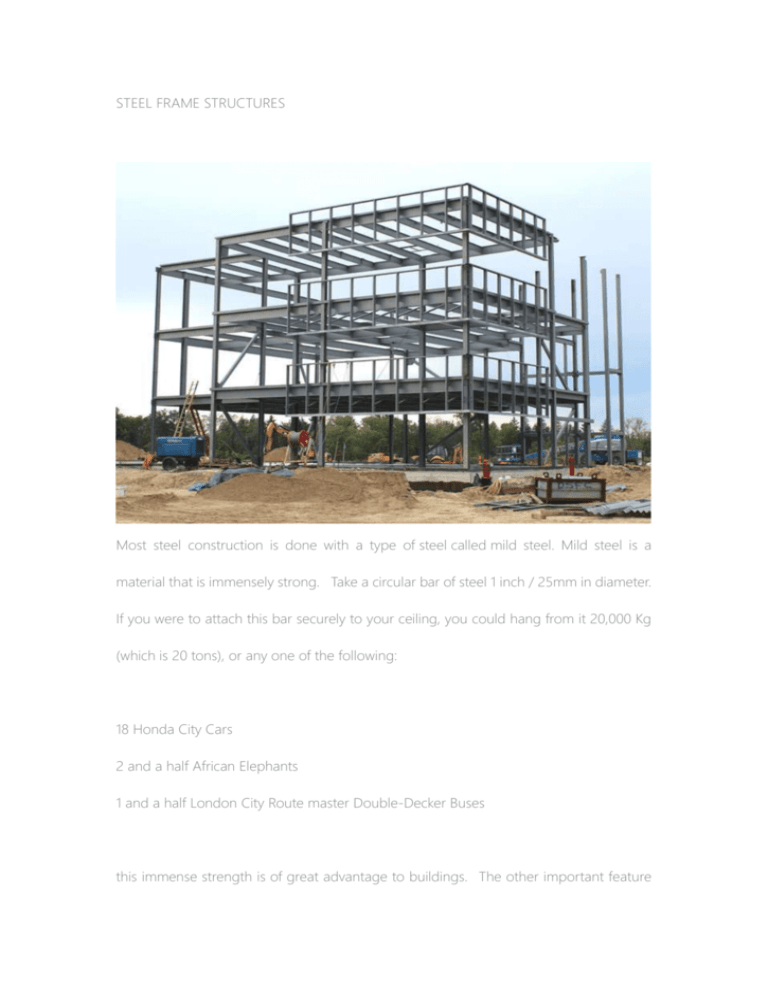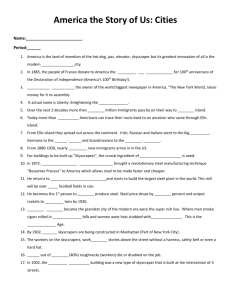- YHS Steel Fabrication
advertisement

STEEL FRAME STRUCTURES Most steel construction is done with a type of steel called mild steel. Mild steel is a material that is immensely strong. Take a circular bar of steel 1 inch / 25mm in diameter. If you were to attach this bar securely to your ceiling, you could hang from it 20,000 Kg (which is 20 tons), or any one of the following: 18 Honda City Cars 2 and a half African Elephants 1 and a half London City Route master Double-Decker Buses this immense strength is of great advantage to buildings. The other important feature of steel framing is its flexibility. It can bend without cracking, which is another great advantage, as a steel building can flex when it is pushed to one side by say, wind, or an earthquake. The third characteristic of steel is its plasticity or ductility. This means that when subjected to great force, it will not suddenly crack like glass, but slowly bend out of shape. This property allows steel buildings to bend out of shape, or deform, thus giving warning to inhabitants to escape. Failure in steel frames is not sudden - a steel structure rarely collapses. Steel in most cases performs far better in earthquake than most other materials because of these properties. However one important property of steel is that it quickly loses its strength in a fire. At 500 degrees Celsius (930 degrees F), mild steel can lose almost half its strength. This is what happened at the collapse of the World Trade Towers in 2001. Therefore, steel in buildings must be protected from fire or high temperature; this is usually done by wrapping it with boards or spray-on material called fire protection. WHERE STEEL FRAME STRUCTURES ARE USED Steel construction is most often used in High rise buildings because of its strength, low weight, and speed of construction Industrial buildings because of its ability to create large span spaces at low cost Warehouse buildings Residential buildings Temporary Structures for the same reason in a technique called light gauge steel construction as these are quick to set up and remove TYPES OF STEEL BUILDING CONSTRUCTION There are several types of steel building construction. Steel construction is also called steel fabrication. Conventional Steel Fabrication is when teams of steel fabricators cut members of steel to the correct lengths, and then weld them together to make the final structure. This can be done entirely at the construction site, which is labor-intensive, or partially in a workshop, to provide better working conditions and reduce time. Bolted Steel Construction occurs when steel fabricators produce finished and painted steel components, which are then shipped to the site and simply bolted in place. This is the preferred method of steel construction, as the bulk of the fabrication can be done in workshops, with the right machinery, lighting, and work conditions. The size of the components are governed by the size of the truck or trailer they are shipped in, usually with a max length of 6m (20ft) for normal trucks or 12m (40ft) for long trailers. Since the only work to be done at site is lifting the steel members into place (with cranes) and bolting, the work at site is tremendously fast. Pre-engineered buildings are an example of bolted steel construction that is designed, fabricated, shipped and erected by one company to the owner. Light Gauge Steel Construction is a type of construction that is common for residential and small buildings in North America and parts of Europe. This is similar to wood framed construction, except that light gauge steel members are used in place of wood two-byfours. Light gauge steel is steel that is in the form of thin (1-3mm) sheets of steel that have been bent into shape to form C-sections or Z-sections. WEIGHT OF STEEL FRAME STRUCTURES Consider a single storey building measuring 5 x 8m (16 x 26ft). Let us first construct this in concrete, with four columns at the corners, beams spanning between the columns, and a 150mm (6") thick concrete slab at the top. Such a structure would weigh about 800 kg/m2, or 32 Tons (32,000 kg) in total. If we build this of steel instead, with a sloping roof covered with corrugated metal sheeting with insulation, this would weigh only about 65 kg/m2. The steel framed building will weigh only 2.6 Tons (2,600 kg). So the concrete building is over 12 times heavier! This is for single storey structures - in multi-storey structures, the difference will be less, as the floors in multi-storey steel buildings are built of concrete slabs for economy - but the difference is still significant. This low weight of steel frame buildings means that they have to be firmly bolted to the foundations to resist wind forces, else they could be blown away like deck umbrellas! ADVANTAGES OF STEEL STRUCTURES Steel structures have the following advantages: They are super-quick to build at site, as a lot of work can be pre-fabbed at the factory. They are flexible, which makes them very good at resisting dynamic (changing) forces such as wind or earthquake forces. A wide range of ready-made structural sections are available, such as I, C, and angle sections They can be made to take any kind of shape, and clad with any type of material A wide range of joining methods is available, such as bolting, welding, and riveting DISADVANTAGES OF STEEL STRUCTURES Steel structures have the following disadvantages: They lose strength at high temperatures, and are susceptible to fire. They are prone to corrosion in humid or marine environments.





